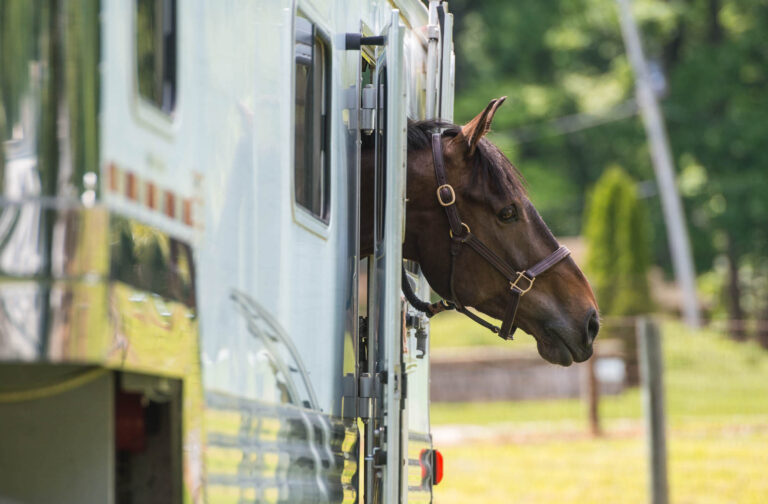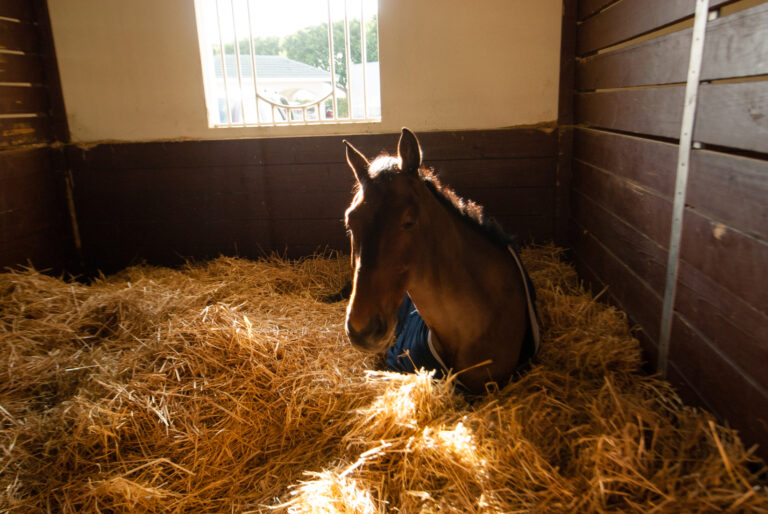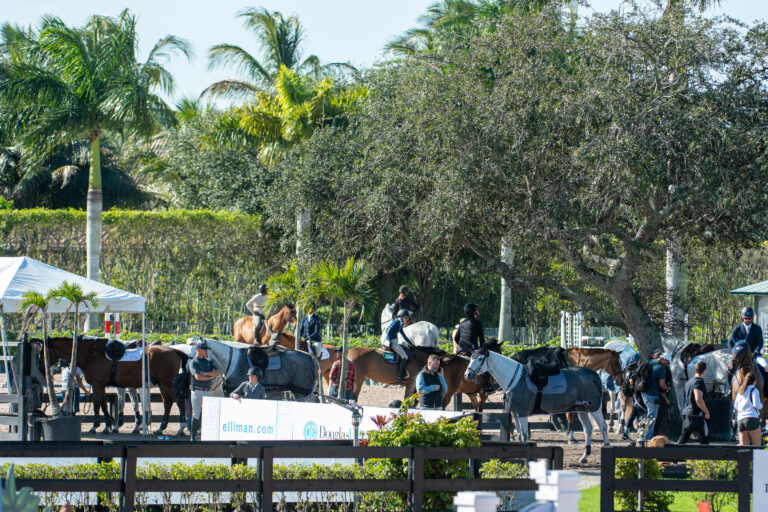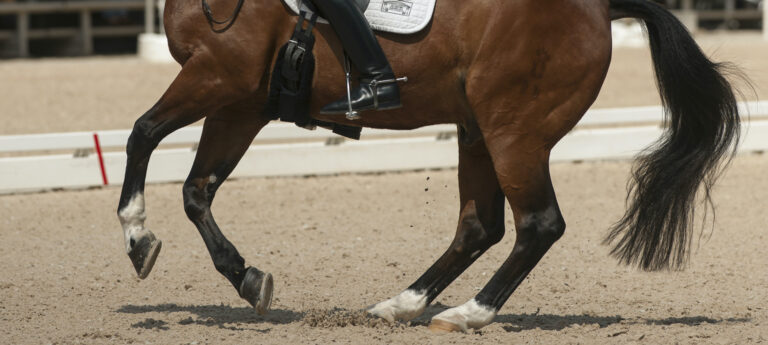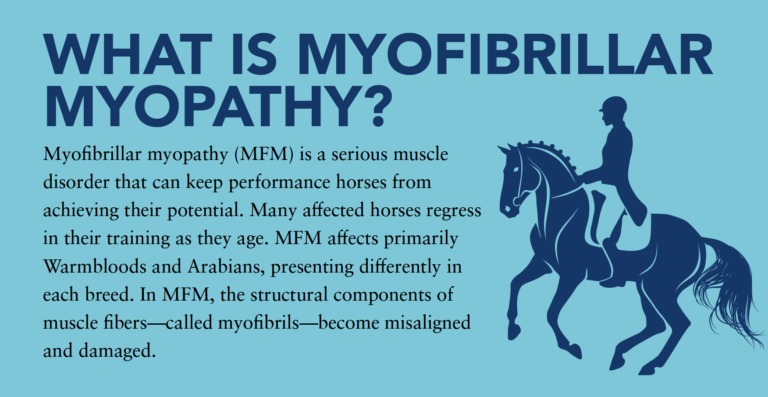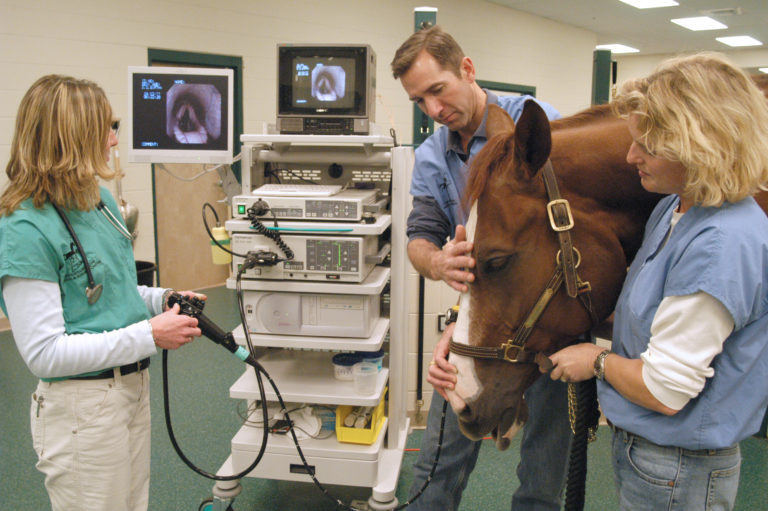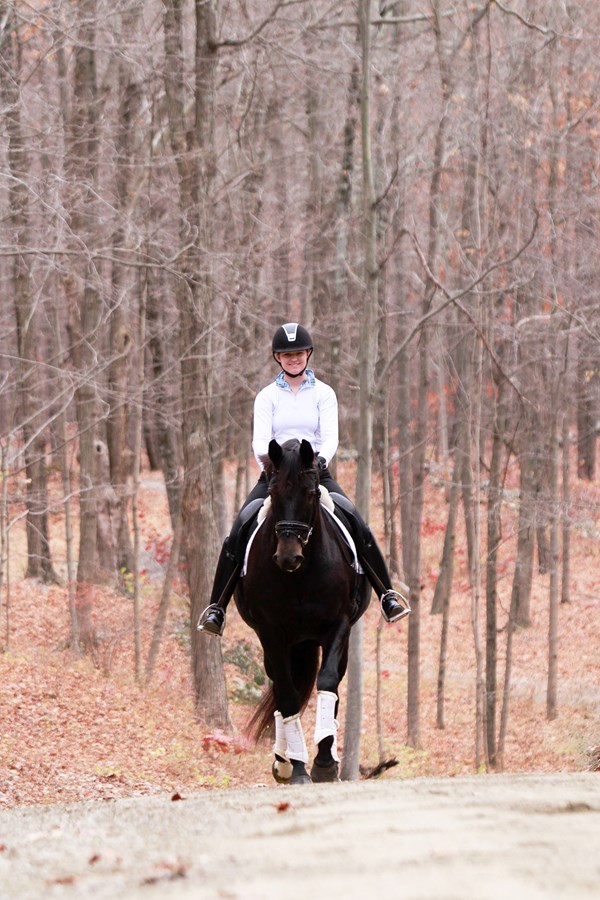
Your horse’s health and fitness play a critical role in his happiness and performance. When it comes to injuries, rehabilitating a horse involves strategic planning and a consistent adherence to a program. The process can be time-consuming and overwhelming, especially with the goal of avoiding re-injury. However, there are certain measures you can take to ensure that your horse’s rehabilitation process goes as smoothly as possible and future injuries are prevented.
Beginning the Rehab Process
USEF Youth Coach George Williams emphasized that teamwork is a large part of rehabilitating a horse. He believes the veterinarian, farrier, dentist, saddle fitter, nutritionist and any masseuse, chiropractor, acupuncturist and trainer should all work together, with you, the rider and the horse’s owner. “You, as the rider, are the team leader,” he said. “The initial steps of this process can be some of the most important that you follow. They serve as a building block for the progress you hope to reach in the future. You, the rider and team leader, should be at the heart of every decision made on your horse’s behalf. No one knows your horse better than you.”
Dr. Hilary Clayton was the dressage chair at Michigan State University and an active researcher and teacher at the Mary Anne McPhail Equine Performance Center, a cutting-edge lameness and equine sports facility. She stressed that the beginning stages of rehabilitation are vital and must be carefully approached. People often try to accelerate the horse’s recovery too quickly, and that is how many horses end up never healing properly and, more often than not, face re-injury.
Williams had a similar opinion: “The most important thing is that you take your time. The biggest mistake people make is that they try to rush the process. For me, it’s really important that I build the horses up slowly and develop strength in a gradual way.”
Depending on the injury, its location, the horse and his overall situation, each rehabilitation process can vary in more ways than one. Dr. Clayton’s approach involves a gradual and progressive increase in the amount of exercise with hill work. In addition, she uses dressage exercises in an interval-training format. For instance, rather than one long workout, she works the horse for perhaps two to four minutes and then takes a break for one to two minutes, and then returns to work, allowing the horse’s muscles to work in increments. Depending on where the horse is in his beginning stages of rehabilitation, the time taken for active work versus short walk breaks depends on his injuries and fitness level and should be decided with the help of your veterinarian. Once the riding process has begun, typically Dr. Clayton dedicates three days a week to conditioning and one day to increasing the workload to build strength.
Dynamic training is also important to Dr. Clayton. This approach emphasizes variation and change, where the horse is worked in different environments, on different surfaces and is introduced to new exercises and training approaches in order to keep his body fit and elastic and his mind fresh and interested. She discussed a case where a horse had recovered from a suspensory injury and rather than return him solely to dressage work, he was hacked for a year and then returned to the dressage arena. That, she says, proved to be the right approach for the horse. However, she consistently emphasized the importance of taking everything in stride and building the horse’s strength gradually.
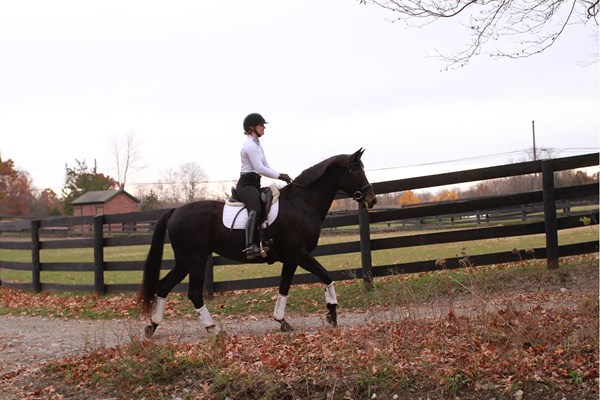
Walking seemed to be the most important activity for dealing with the early stages of an injury case.Walking, according to Dr. Clayton, is ideal because, in the beginning stages of recovery, the tendons and ligaments are healing and new fibers are forming and need to be properly aligned in order for the treatment to reach success. Walking helps to align the fibers and strengthen the tendons and ligaments without stressing them too much through impact and concussion.
Williams takes a similar approach, making sure that the horse has the proper amount of walking time before moving any further into the strengthening process. However, when it is time to begin trotting, he makes sure that it is done only on straight lines, without corners or turns. In regard to movements, Williams said, “I always wait on the flying changes because of the strain it puts on the legs on the landing.” Lateral work is a major component of your horse’s program and should also be carefully considered with your veterinarian as to when it should begin.
The importance of patience was also a recurring theme. Williams said that it sometimes takes three to six months of stall rest before the horse starts his rehab work and sometimes it is a year before a horse begins to feel the way he did before he was injured. As riders, we must embark on the process with an understanding that everything is going to take time and will require patience.
Cavalletti and Hill Work
Hill and cavalletti work have proven to be excellent ways to both rehabilitate an injured horse and build or maintain muscle and fitness on a sound horse. Dr. Clayton said that cavalletti work is a great tool because it gets a horse to use his full range of motion without increasing the strain on his legs. The use of cavalletti is a great strengthening technique and has proven to be successful in more ways than one. The horse is asked to use every joint in his body from the ground up and in the correct way, which ensures that each facet of the horse’s body is being exercised and strengthened properly.
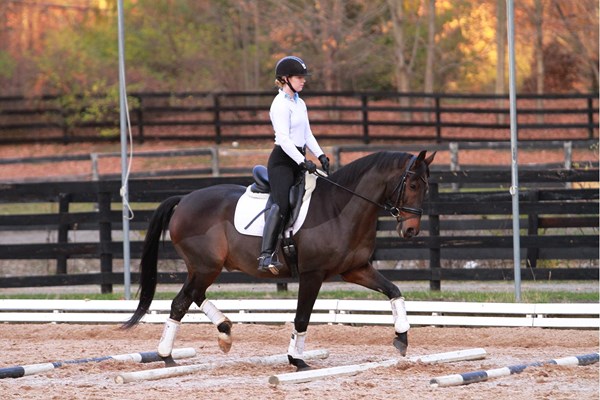
Dr. Clayton explained the benefits of hill work in two parts: the uphill workout and the downhill workout. “The uphill,” she said, “increases the cardiovascular load without increasing the loading on the forelimbs. The extra load is all on the hind legs and that’s where you want the horse to build strength. Uphill work is excellent for developing hind-limb strength. On the downhill,” she says, “go slowly. Otherwise, you increase the concussion on the legs. If you walk slowly and carefully, you can build up muscles for collection.”
Variety proves to be important, both in rehabilitation cases and in training programs. As a general guideline, a horse needs different ways to use his mind and condition his body.
Rehabilitation Facilities
Utilizing rehabilitation facilities can be a great way to approach the beginning stages of the rehab process. The main draw to these facilities is access to a dry or aqua treadmill. Dr. Clayton said there are many rehab facilities available for small animals because fewer resources are needed.
However, a facility specifically designed to cater to the equine athlete is more of an investment, which makes them more rare and something that isn’t always within reach for every owner. She said that some of the current rehabilitation facilities are excellent; some have sophisticated equipment that an ordinary vet would not have. Dr. Clayton feels that two of the more important things to consider when choosing a rehab facility are the equipment and the qualifications of the people working at the establishment. It is very important that you feel they are competent and knowledgeable in making the appropriate decisions for your horse’s conditioning plan. With that said, a veterinarian who is either on the facility’s team or makes frequent trips to the location is vital. It is important that he or she is consistently involved throughout the process so progress can be tracked and decisions made accordingly.
Typically, rehabilitation facilities can be found through your veterinarian. It is safest to choose a place based on his or her recommendation, since he or she has most likely dealt with a specific facility before and has a professional opinion about whether it is worth the investment, and whether or not it has positive and proven results.
These facilities cost more than an owner’s typical monthly board expenses. It can vary depending on the facility, but most places will charge a flat rate for board (standard mucking, feeding, hay, etc.) and then an additional fee for services such as bandaging, administration of medication, hand-walking, hand-grazing, accompanied vet visits, etc.
On top of this, the use of a treadmill, depending on how frequently the horse uses it per month, is an additional cost. Water treadmills require more electric and water usage from the facility, which is where the fee usually stems from. Depending on the vet’s recommendation, a horse stays at a rehabilitation location based on the extent of his injury and the chosen treatment. If a horse is there solely to benefit from the use of the water treadmill, he may need to stay only for a short time. Depending on the facility, trailer-in options can be arranged.
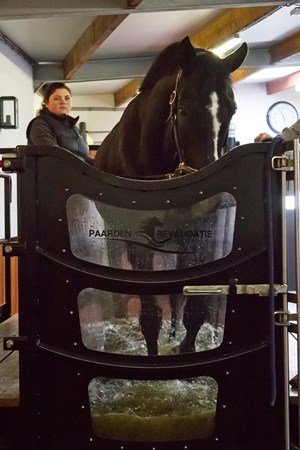
When discussing the aqua treadmill, Dr. Clayton referenced Dr. Melissa King from Colorado State University. She has done quite a bit of research on the water treadmill, and she finds it a successful rehabilitation technique. With this approach, the treadmill serves as a way to off-load the leg. The way Dr. Clayton describes it in human terms: When you swim to the deeper end of a pool, you feel the water start to carry more and more of your body weight. The same goes for the horse. As the treadmill fills with water, more of the horse’s body weight is carried by the water, resulting in less strain on the limbs, yet he still builds muscle.
The Turnout Debate
For many people, the thought of returning a recovering horse to turnout is terrifying. Dr. Clayton says that owners have a right to be concerned, especially when the horse is still in the recovery process. The last thing you want as a rider and/or owner is for the horse to experience a re-injury. She says, “When we start turning out we use a small paddock—so small that the horses don’t have room to gain speed. Sometimes we sedate them for the first few times.”
As Williams mentioned, the rider serves as the team leader during this process and turnout is one of the areas where the rider should use her relationship with the horse to exercise the best judgment. Once you have received the OK from your veterinarian, turnout can be a big step in the process, considering the risk involved. Dr. Clayton, however, said that, “It’s all about knowing your horse and whether you can trust him in turnout or whether it’s better to ride him or hand-graze or even hand-walk instead. It’s different with every horse.”
When asked how he approaches turnout with horses coming back into work, Williams said jokingly, “I cover my eyes.” But, he admits, it is a serious step for the horse, especially if he has endured a long recovery process. “Ultimately, as long as the horse is healthy again, it’s better for him to be out and stretching his legs,” he said.
He stressed the importance of being practical and thinking logically when making decisions. Sometimes, calming agents can be useful because they help ensure the horse’s safety. He explains how some people are too proud to admit their horse might need the help of a calming agent, but ultimately your horse’s safety should be your top priority and, in this instance, it is important to think about the “what if.”
Preventive Measures
For an owner who is seeking ways to maintain a sound horse, proper warm-up, cool down and the behind- the-scenes maintenance of the horse proves to be critical.
Charlotte Bredahl-Baker, USEF assistant youth coach, said, “I am very diligent about taking my time warming the horses up and cooling them down. I do at least 10 minutes of stretchy work before real work and another 10 minutes or so for cool down with hand-walking. If it is cool, my horses will get covered with a cooler while being hand-walked. I even keep them covered while in cross ties if they are sweaty at all to make sure their muscles don’t get cold.”
According to Williams, proper attention to footing is very important. He said that when he is traveling to shows and the footing is not ideal, he wraps his horses at night and sometimes applies a poultice as an added precaution. He added that it is crucial for the rider to be diligent about looking after her horse’s legs and she should always be mindful about her training regime.
Pay attention to things that could stress the horse and be aware of certain movements, such as the extended trots, piaffe/passage and pirouettes, all of which ask for a high degree of collection. Do not drill him too much or too often. With an older horse, for instance, Williams is especially mindful of this. As part of his routine, the horses who are working and training hard are typically bandaged at night to help keep the legs clean and minimize wind puffs.
Both Dr. Clayton and Williams commented on the importance of icing the horse’s legs after a workout. Icing tightens local blood vessels and lowers tissue temperature, resulting in a decrease in inflammation, pain, swelling and tissue damage while promoting healing and quickening the delivery rate of nutrients to the iced area. The treatment should last between 15 and 20 minutes and is recommended after every ride, regardless of the training session’s intensity.
There are a variety of ice boots on the market that do an excellent job. Whirlpool boots have proven to be another popular option for icing as well.
General maintenance doesn’t always mean medical maintenance. It also means proper attention to competition schedules and training regimes. Bredahl-Baker’s horse, Monsieur, was a successful Grand Prix horse for 10 years, from the age of 9 to 19 and he lived to be 35.
She credits his long and successful career to her selectivity. She did not compete him too much and was careful not to practice a lot of extensions and drill certain movements. Bredahl-Baker also made sure her horse received proper time off. She remembers giving him close to two weeks off at a time so he had a chance to rest both his mind and body.
She also is a huge believer in turnout for horses. Monsieur received regular turnout, and Bredahl-Baker feels that it is crucial for horses to get time outside. “I have always been a big fan of turnout and think it is a crime to keep a horse locked up 23 hours a day. I think small turnouts are great so the horses can’t pick up much speed.” Small turnouts can be thought of as an outdoor stall, a small, enclosed area typically measuring 12 feet by 12 feet, 12 by 14 or 14 by 14.
Bredahl-Baker goes on to say, “I also like to have double fencing, so the horses can’t fight across the fence boards, but it is critical to always have several horses next to each other. If they don’t have neighbors when they are turned out, they will get upset and run around. My horses go out in a cluster of four turnouts. In the center they all have freedom feeders, so they all get together in the middle to eat most of the day. Having hay in front of them all day is great for their digestion and keeps them happy and mellow and not running around. It is also great prevention for colic.”
Bredahl-Baker feels that regular dentistry is important as well, noting that she has her horses checked every six months. Both Dr. Clayton and Bredahl-Baker emphasize the importance of a good farrier and correct shoeing. Dr. Clayton said it is vital to have a farrier who can balance the horse well, and Bredahl-Baker typically obtains X-rays of her horse’s feet so that the farrier can examine how the shoeing is affecting them.
After a diagnosis from your veterinarian, the rehabilitation process is a critical time. In order to avoid re-injury, additional injuries or any complications, your veterinarian’s suggested course of treatment must be adhered to down to the most minute details.
Injuries can be devastating setbacks, but if a rider approaches the situation with the best treatment plan possible, one that is tactful and effective, the likelihood of returning a horse to regular training and competition is far more probable.
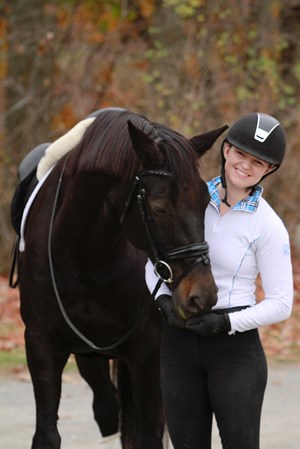
Lilly Simons is a USDF bronze and silver medalist. In 2015 she competed at the North American Junior/Young Rider Championships as a member of Region 8’s Young Rider Team. Later she was invited to the USEF High Intensity Training Session at the USET Headquarters in Gladstone, New Jersey. From there, she traveled to the Young Rider Nationals in Wayne, Illinois, where she placed fifth with Willoughby, her own13-year-old KWPN gelding, to whom she credits her success. She currently trains with Wes Dunham in Millbrook, New York, and plans to move into the U-25 division in the 2017 season.


